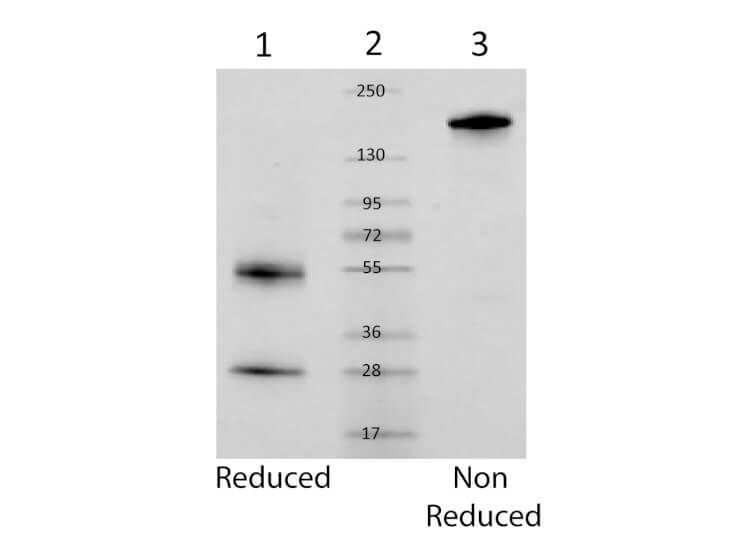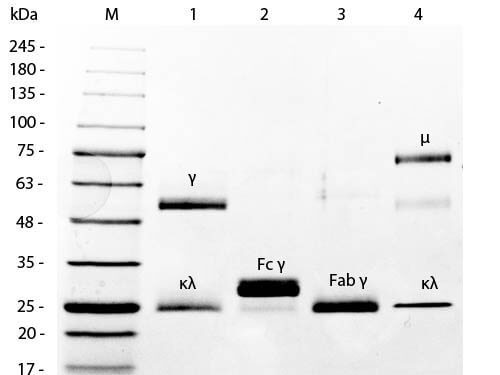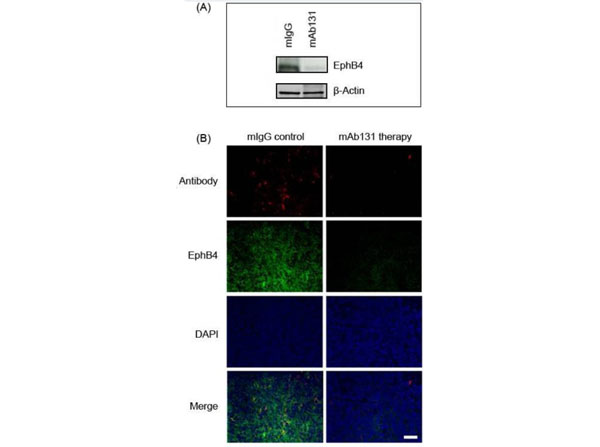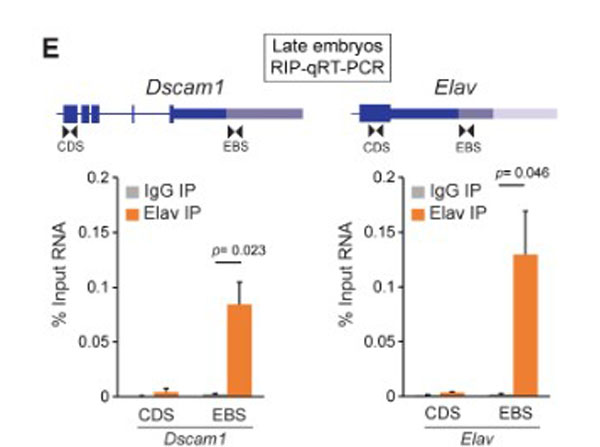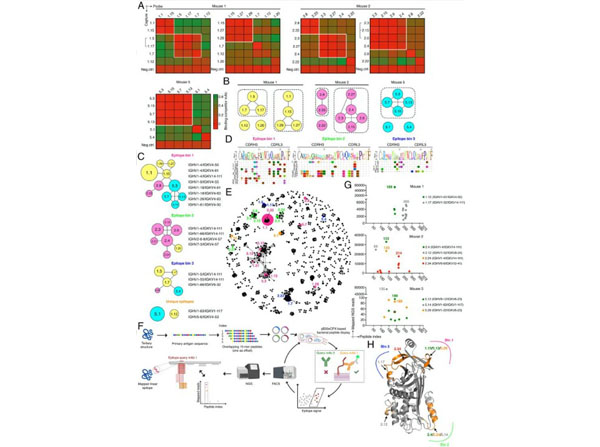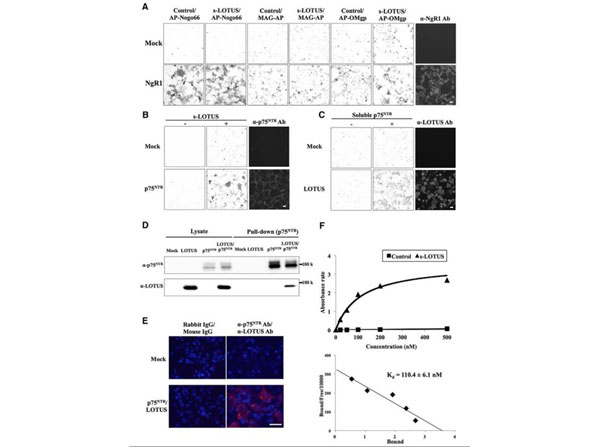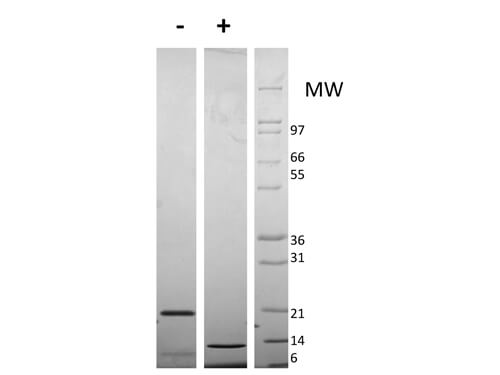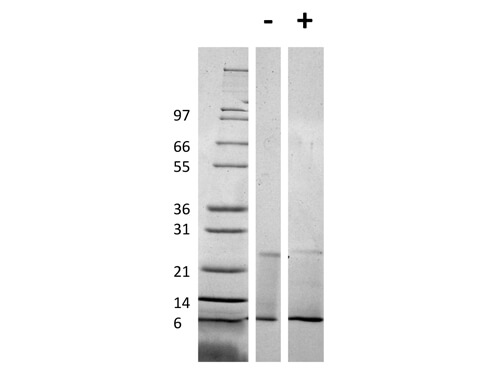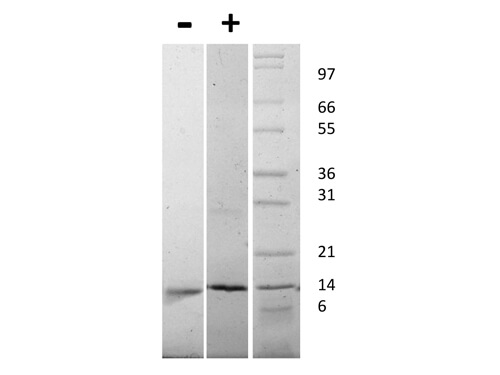Mouse IgG
15 References
010-0102
010-0102-1000
010-0102-0005
25 mg
1 g
5 mg
Lyophilized
Liquid (sterile filtered)
Lyophilized
WB, ELISA, IF, FC, SDS-PAGE, Multiplex, Other
Mouse
Shipping info:
$50.00 to US & $70.00 to Canada for most products. Final costs are calculated at checkout.
Product Details
Mouse IgG Whole Molecule (BULK ORDER) - 010-0102
Immunoglobulin G from Mouse, IgG from Mouse, purified polyclonal IgG antibody
Mouse
IgG
Native Protein
Target Details
Mouse IgG was prepared from normal mouse serum by a multi-step process which includes delipidation, salt fractionation and ion exchange chromatography followed by extensive dialysis against the buffer stated above. Assay by immunoelectrophoresis resulted in a single precipitin arc against anti-Mouse IgG and anti-Mouse Serum.
Application Details
SDS-PAGE
ELISA, FC, IF, Other, WB, Multiplex
- View References
Mouse IgG whole molecule has been tested in SDS-Page and can be utilized as a control or standard reagent in SDS, Western Blotting, and ELISA experiments.
Formulation
10.0 mg/mL by UV absorbance at 280 nm
0.02 M Potassium Phosphate, 0.15 M Sodium Chloride, pH 7.2
0.01% (w/v) Sodium Azide
None
2.5 mL
Restore with deionized water (or equivalent)
Shipping & Handling
Ambient
Store purified Mouse IgG at 4° C prior to restoration. For extended storage aliquot contents and freeze at -20° C or below. Avoid cycles of freezing and thawing. Centrifuge product if not completely clear after standing at room temperature. This product is stable for several weeks at 4° C as an undiluted liquid. Dilute only prior to immediate use.
Expiration date is one (1) year from date of receipt.
Mouse IgG purified protein (Immunoglobulin G) are antibody molecules. Mouse IgG is composed of four peptide chains — two heavy chains and two light chains. Mouse IgG has two antigen binding sites. Other Immunoglobulins may be described in terms of polymers with the IgG structure considered the monomer. Mouse IgG typically constitutes 75% of serum immunoglobulins. Mouse IgG molecules are synthesized and secreted by plasma B cells. Ideal as a negative control for Flow Cytometry, Western blotting, immunoprecipitation and immunohistochemistry applications.
Wedegaertner H et al. (2023). Divergent regulation of α-arrestin ARRDC3 function by ubiquitination. Mol Biol Cell.
Applications
WB, IB, PCA
Neumeier, D et al. (2022). Phenotypic determinism and stochasticity in antibody repertoires of clonally expanded plasma cells. Proceedings of the National Academy of Sciences of the United States of America
Applications
FC, FACS, FLOW
Arakaki AKS et al. (2021). α-arrestin ARRDC3 tumor suppressor function is linked to GPCR-induced TAZ activation and breast cancer metastasis. J Cell Sci.
Applications
Undefined
Neumeier D et al. (2021). Phenotypic determinism and stochasticity in antibody repertoires of clonally expanded plasma cells. bioRxiv Preprint
Applications
EIA, ELISA
Mason BM et al. (2021). Optimization of therapeutic antibodies by predicting antigen specificity from antibody sequence via deep learning. Nat Biomed Eng.
Applications
Undefined
Virtakoivu R et al. (2021). Systemic Blockade of Clever-1 Elicits Lymphocyte Activation Alongside Checkpoint Molecule Downregulation in Patients with Solid Tumors: Results from a Phase I/II Clinical Trial. Clin Cancer Res.
Applications
IF, Confocal Microscopy
Fair-Makela R et al. (2020). Robo4 contributes to the turnover of Peyer's patch B cells. Mucosal Immunol.
Applications
Other
Matsumura T et al. (2019). Sequential Sensing by TLR2 and Mincle Directs Immature Myeloid Cells to Protect against Invasive Group A Streptococcal Infection in Mice. Cell Rep
Applications
Control
Zhang Z et al. (2019). Elav-mediated exon skipping and alternative polyadenylation of the Dscam1 gene are required for axon outgrowth. Cell Rep
Applications
qRT-PCR, RT-PCR
Kawakami Y et al. (2018). The soluble form of LOTUS inhibits Nogo receptor-mediated signaling by interfering with the interaction between Nogo receptor type 1 and p75 neurotrophin receptor. J Neurosci.
Applications
E, EIA; Other
Kruse N et al. (2016). A First Tetraplex Assay for the Simultaneous Quantification of Total α-Synuclein, Tau, β-Amyloid42 and DJ-1 in Human Cerebrospinal Fluid. PloS One
Applications
E, EIA
Bronietzki M et al. (2014). Study of phagolysosome biogenesis in live macrophages. J Vis Exp.
Applications
Ab Immobilization
Li, D et al. (2013). Targeting the EphB4 receptor for cancer diagnosis and therapy monitoring. Molecular Pharmaceutics
Applications
WB, IB, PCA; IF, Confocal Microscopy; Immunization
Penaranda, C et al. (2011). Anti-CD3 therapy promotes tolerance by selectively depleting pathogenic cells while preserving regulatory T cells. Journal of Immunology (Baltimore, Md. : 1950)
Applications
FC, FACS, FLOW; Cellular assay
Ono K et al. (2006). Caenorhabditis elegans kettin, a large immunoglobulin-like repeat protein, binds to filamentous actin and provides mechanical stability to the contractile apparatuses in body wall muscle. Mol Biol Cell.
Applications
IF, Confocal Microscopy; Multiplex Assay
This product is for research use only and is not intended for therapeutic or diagnostic applications. Please contact a technical service representative for more information. All products of animal origin manufactured by Rockland Immunochemicals are derived from starting materials of North American origin. Collection was performed in United States Department of Agriculture (USDA) inspected facilities and all materials have been inspected and certified to be free of disease and suitable for exportation. All properties listed are typical characteristics and are not specifications. All suggestions and data are offered in good faith but without guarantee as conditions and methods of use of our products are beyond our control. All claims must be made within 30 days following the date of delivery. The prospective user must determine the suitability of our materials before adopting them on a commercial scale. Suggested uses of our products are not recommendations to use our products in violation of any patent or as a license under any patent of Rockland Immunochemicals, Inc. If you require a commercial license to use this material and do not have one, then return this material, unopened to: Rockland Inc., P.O. BOX 5199, Limerick, Pennsylvania, USA.

